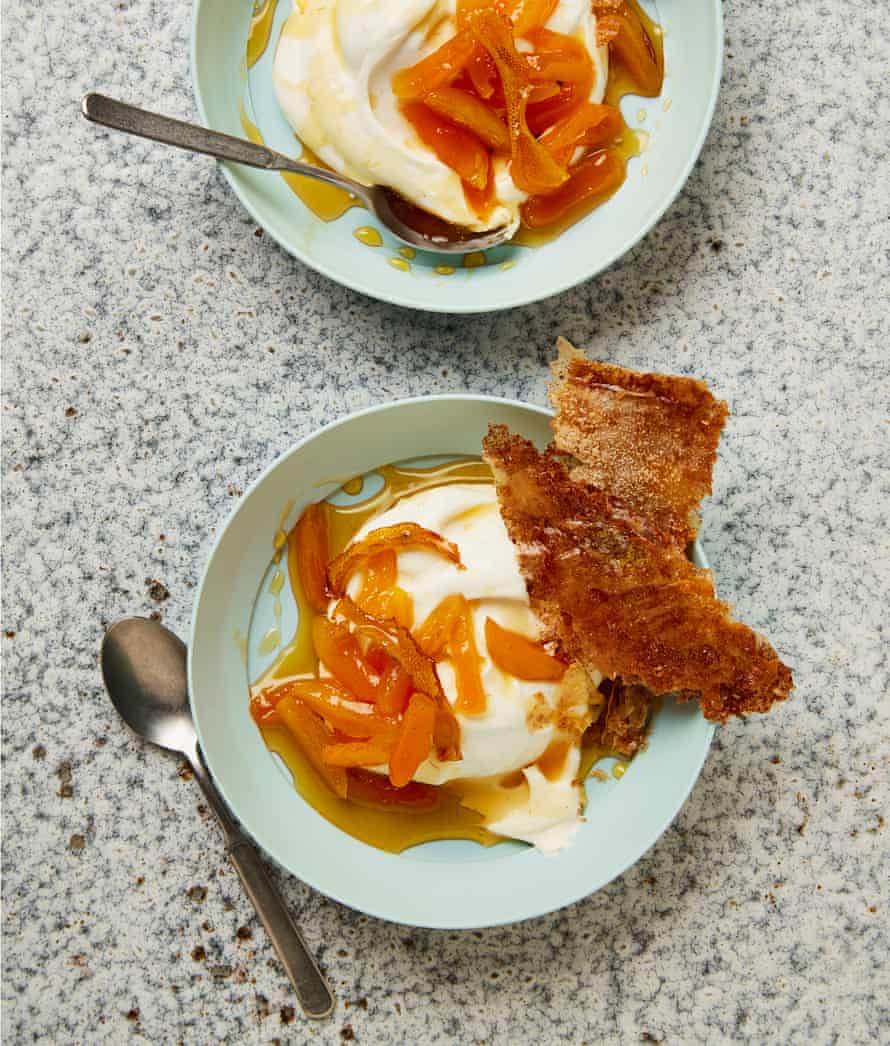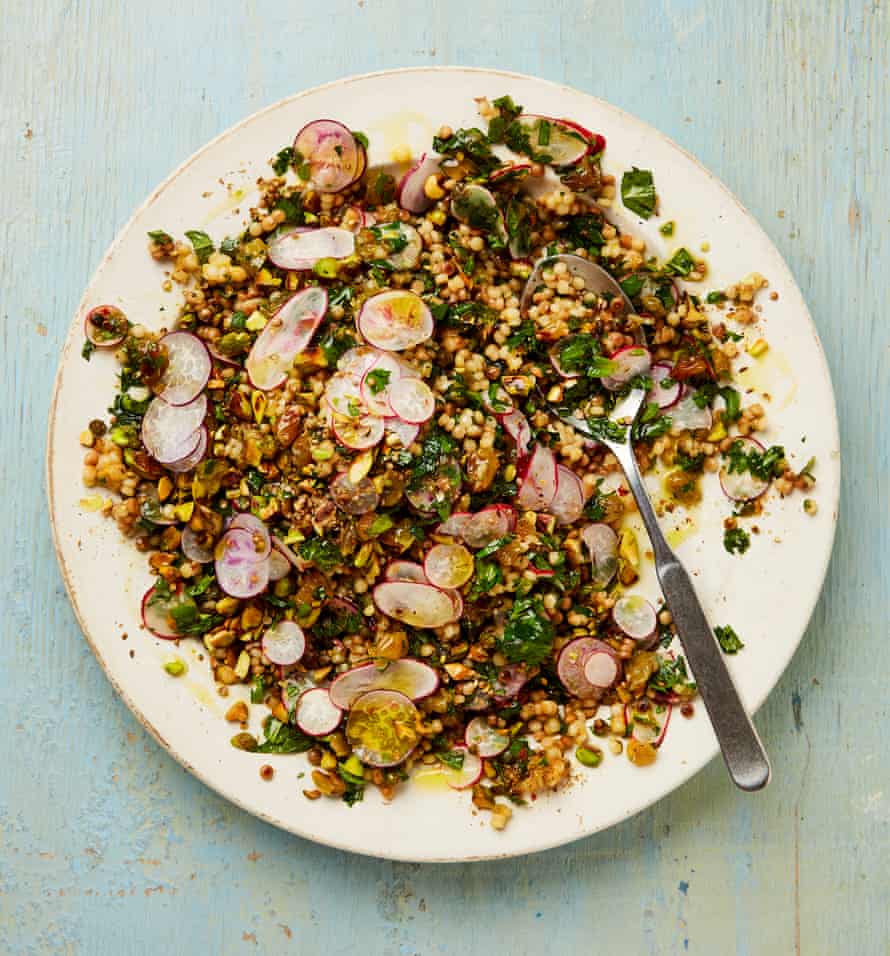Shared from www.theguardian.com
Cooking with dried fruit, as opposed to just snacking on it, makes particular sense when we’re all waiting for the new season’s fruit and veg to arrive. When fruit is dried, the water inside is taken out and its natural sugars are concentrated. Rehydrating them by cooking them means they plump up, soften and retain all that jammy sweetness.
Pork ribs with fig barbecue sauce and spring onion salsa
The sauce here can be used to marinate other meat, such as chicken wings or lamb ribs. If you like, get ahead by making the sauce and marinating the ribs the day before you want to eat them.
Prep 20 min
Marinate 3 hr+
Cook time: 3 hr 15 min
Serves 4
For the ribs
4 garlic cloves, peeled and crushed
2 tbsp lime juice (ie, from 2 limes), plus 2 tbsp extra for the salsa
1 tbsp olive oil
Salt and black pepper
1.2kg pork ribs (ie, 2 large racks)
500ml chicken stock
For the sauce
100g soft dried figs, roughly chopped
1 tsp chipotle chilli flakes
1½ tbsp olive oil
1 fresh bay leaf
1 whole star anise
1 onion, peeled, halved and thinly sliced (180g)
2 garlic cloves, peeled and roughly chopped
1½ tsp tomato paste
1½ tsp Worcestershire sauce
2 tbsp maple syrup
2½ tbsp apple cider vinegar
For the salsa
5 spring onions, trimmed and finely chopped (50g)
25g parsley leaves, finely chopped
2 tbsp olive oil
Salt
First, marinate the ribs. Put the garlic, two tablespoons of lime juice, oil and a teaspoon of salt in a large, 30cm x 20cm baking dish and mix well. Add the ribs and rub all over with the marinade. Cover (I use reusable kitchen wrap) and refrigerate for at least three hours, and up to overnight.
Meanwhile, make the sauce. Put the figs and chipotle in a small bowl, cover with 500ml boiling water and set aside for 15 minutes, until nicely softened.
Put the oil in a large saute pan for which you have a lid, and set it over a medium-high heat. Once hot, add the bay leaf, star anise, onion and garlic, and cook, stirring occasionally, for 15 minutes, until the onions are soft and golden. Stir in the tomato paste, cook for a minute more, then add the figs and their soaking water, the Worcestershire sauce, maple syrup and vinegar. Stir, cover and leave to simmer for 13-15 minutes, until the figs are soft enough to easily be crushed with the back of a spoon. There should still be enough liquid left in the pan to half-submerge the figs, so if the sauce looks dry, add a splash more water.
Off the heat, remove and discard the bay leaves and star anise, then tip the mix into the bowl of a large food processor, add a half-teaspoon of salt, blitz smooth and leave to cool.
About half an hour before you want to cook them, take the ribs out of the fridge, so they come up to room temperature. Heat the oven to 180C (160C fan)/350F/gas 4. Pour the barbecue sauce all over the ribs, mixing to coat them, then pour in the stock around but not over the meat. Cover the dish tightly with foil, so no steam can escape, then bake for three hours, basting every hour, until the meat is tender and almost falling apart. If the sauce looks as if it’s reducing too much, add a splash more water when basting.
Remove the dish from the oven and turn the grill to its highest setting. Carefully lift the ribs from the tray and tip the cooking juices into a small saucepan. Put the pan on a medium-high heat and cook, stirring occasionally, for 10 minutes, until the sauce thickens to a ketchup-like consistency.
Put the ribs back in the baking dish, pour the reduced cooking juices all over them, then grill for seven to nine minutes, until nicely charred.
Meanwhile, make the salsa. In a small bowl, mix the spring onions, parsley, two tablespoons of lime juice, the oil and an eighth of a teaspoon of salt.
To serve, place the ribs on a large platter and pour over any liquid left in the baking dish. Spoon the salsa all over the top and serve warm.
Giant couscous with herbs, pistachios and spicy raisin dressing
This is a great make-ahead dish, with both the couscous and spicy dressing happy to be made the day before and kept in the fridge, ready for the fresh herbs to be stirred through just before serving. Sultanas and chopped apricots will also work very well, if you cannot get hold of golden raisins.
Prep 30 min
Cook 30 min
Serves 6
250g giant couscous (aka pearl couscous)
500ml vegetable or chicken stock
Salt and black pepper
40g parsley leaves, roughly chopped
20g mint leaves, roughly chopped
2 tsp coriander seeds, toasted and lightly crushed in a mortar
60g pistachios, lightly toasted and roughly chopped
100g rainbow radishes, trimmed and cut into very thin rounds
For the spicy raisin dressing
80g golden raisins (or sultanas), roughly chopped
2 tbsp runny honey (or maple syrup, to make the dressing vegan)
80ml apple cider vinegar
¾ tsp chilli flakes
3 tbsp olive oil
50g baby capers, plus 2 tsp caper brine
Put the couscous in a medium saucepan for which you have a lid, and set it over a medium-high heat. Dry-fry the couscous for about seven minutes, stirring occasionally, until toasted and browned in places. Pour in the stock and a half-teaspoon of salt, then bring to a boil. Cover, turn the heat down low and leave to cook undisturbed for 10-12 minutes, until all the liquid has been absorbed. Take off the heat, leave to sit, still covered, for 10 minutes, then uncover and set aside to cool to room temperature.
To make the dressing, put the raisins, honey, vinegar and chilli flakes in a small saucepan on a medium-high heat, and simmer for seven minutes, until the raisins are plump. Take off the heat and leave to cool. Once cool, stir in two tablespoons of the oil and the capers and caper brine.
Put the couscous in a large bowl, top with the dressing, herbs, half each of the coriander seeds, pistachios and radishes, and mix well to combine. Transfer to a large, shallow bowl or lipped platter, scatter over the remaining coriander seeds, pistachios and radishes, then drizzle with the last tablespoon of oil and serve.
Yoghurt cream with sticky apricots and filo wafer

This is satisfyingly sweet without being overly filling. You’ll make more of the filo wafer than you need, but you’ll be happy for it: the egg white brushed on top makes it especially crisp, and it’ll keep in an air-tight container for crumbling over ice-cream or creamy oats.
Prep 25 min
Cook 35 min
Serves 4
For the filo wafer
4 sheets good-quality filo pastry
40g unsalted butter, melted
1 tsp ground cinnamon
¾ tsp flaked sea salt
3⅔ tbsp caster sugar
1 egg white, beaten (30g)
For the yoghurt cream
200ml double cream
1 tbsp caster sugar
1½ tsp vanilla bean paste
120g thick-set Greek yoghurt
8 cardamom pods, bashed open, shells removed and seeds finely crushed in a mortar
For the sticky apricots
60g runny honey
30g caster sugar
⅛ tsp tsp flaked sea salt
5 cardamom pods, bashed open with the flat of a knife
1-2 lemons, zested, to get 6 strips of finely shaved skin, and juiced, to get 2 tbsp
90g soft dried apricots, each cut into 3-4 strips
1½ tsp orange blossom water
Heat the oven to 180C (160C fan)/350F/gas 4. First, make the filo wafer, keeping the filo sheets under a damp cloth so they don’t dry out. Lay out one sheet of filo on a clean, dry worktop and brush all over with a third of the butter. Sprinkle over a third of a teaspoon of cinnamon, a quarter-teaspoon of flaked salt and two teaspoons of sugar. Lay another sheet of filo on top of the first sheet, and repeat the brushing and sprinkling process twice more to use up three sheet of filo, all the remaining butter, cinnamon and salt and all but two teaspoons of the sugar. Lay the fourth and final sheet of filo on top, then brush all over with the beaten egg white – you will need only about two-thirds of it to cover. Sprinkle over the remaining two teaspoons of sugar and transfer to a large baking tray lined with greaseproof paper. Bake for 20-25 minutes, or until deeply golden, then remove and leave to cool completely. Once cool, break into random, bite-sized shards.
While the filo is baking, make the yoghurt cream. Put the cream, sugar and vanilla in a large bowl and whisk to barely soft peaks (take care not to over-whisk it, because the cream will thicken slightly when it’s chilled). With a spatula, gently fold in the yoghurt and cardamom, then refrigerate until nice and cold.
Now make the sticky apricots. Put the honey, sugar and salt in a small, nonstick frying pan set over a medium-high heat and cook, stirring occasionally, for four minutes, until the mixture is bubbling and starting to brown. Add the cardamom pods and lemon strips, and cook for 90 seconds more, until very fragrant and nicely coloured. Take off the heat, then immediately stir in the apricots, lemon juice, orange blossom water and two tablespoons of cold water, then set aside to cool completely (the syrup will thicken as it sits).
Divide the cold yoghurt cream between four small bowls, top with the some of the sticky apricots and a shard of filo wafer, and serve with extra filo wafers in bowls alongside.
Images and Article from www.theguardian.com

